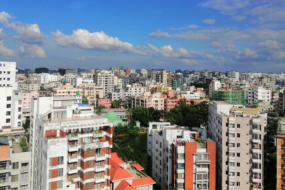Despite the challenges posed by recurring waves of covid-19 infections, supply chain disruptions due to increased geo-political tensions and resultant inflationary pressures , rising interest rates and property prices, demand for homes is unlikely to be dented.
While growth expectations in India too have been tempered due to global headwinds, India is still expected to be amongst the fastest growing major economies with GDP growth estimated at above 7% for the current year, powered largely by domestic consumption, increased capital expenditure by the government, strong agricultural growth and higher capacity utilisation. All these factors augur well for India’s growth potential.
In India, while inflationary expectations are likely to remain above RBI’s comfort zone of 6% over the next 3 quarters, India’s increase in inflation rates is not because of excess demand. The root of India’s current inflation is the supply side — largely driven by higher oil and commodity prices which in turn is amplified due to geo-political tensions. Once supply chain disruptions ease, India’s inflation rate is also likely to temper downwards.Due credit must be given to the government and the RBI who are working in tandem to rein in inflation and ease the burden on the common man.
Now as far as home loans are concerned, we have had an exceptionally good run with the strong demand for housing coupled with interest rates at an all-time low. As you would recall, in the month of March 2022, HDFC had recorded its highest number of Individual loan receipts at over 86,000. In the last financial year, our individual approvals and disbursals grew by 38 percent and 37 percent respectively. The average size of individual loans stood at Rs 33 lakhs , compared to Rs 29.5 lakh in the previous year. The Assets Under Management (AUM) as on 31 March 2022, stood at Rs 6,53,902 crore as against Rs 5,69,894 crore in the previous year. Much of this was attributed to seamless operations and ability to stay connected with customers by leveraging on our digital platforms, leading to strong demand for both affordable housing and high end segments.
I continue to maintain that despite changes in the macro environment, the growth potential for housing in India remains immense. Property prices are seeing measured increases, to the extent of the rise in input costs. Yet, developers are unlikely to opt for sharp increases because they recognise that outpricing home buyers and having large stocks of unsold inventory is counter productive for them.
There has been consolidation and cleansing so to speak, in the Indian real estate space. The weaker players have been weeded out of the market. Recent new launches have been by stronger, reputed developers and this has meant that home buyers too have the confidence to once again opt for under-construction properties, rather than playing safe and preferring only completed projects. Six years of RERA has also empowered home buyers. To my mind, real estate in India will continue to be on an up cycle.
Now let me address the issue of interest rates. During the peak of the pandemic, the RBI reduced the repo rate by 115 basis points in quick succession, besides other liquidity measures to support the economy. This position is now being unwound. It was unrealistic to believe that such low interest rates and high levels of surplus liquidity would sustain.The reality is that markets began to pencil in expectations of policy rate increases from October 2021 itself, when the variable reverse repo rates began aligning with the repo rates.The RBI has front-loaded its policy rate hikes. RBI has rightly articulated a withdrawal of its accommodative stance to ensure inflation reverts to RBI’s target range, whilst also supporting growth in the economy.
The demand for housing is unlikely to be impacted by interest rate increases. In fact, current interest rates on home loans are still below pre-pandemic levels and further, a home loan is for a long tenor and during this period there are bound to be both, upward and downward interest rate cycles.
Key Sustainability Features in Office of the Future
1 Biophilia
Office space with lots of plants and outdoor space like roof top gardens etc.
2 Water Conservation
Water recycling and water treatment onsite
3 Green Business Practices
100 percent green procurement
4 Sustainable Business Practices
Office furniture made from recycle material
5 Energy Conservation
Artificial Intelligence for energy efficient consumption





